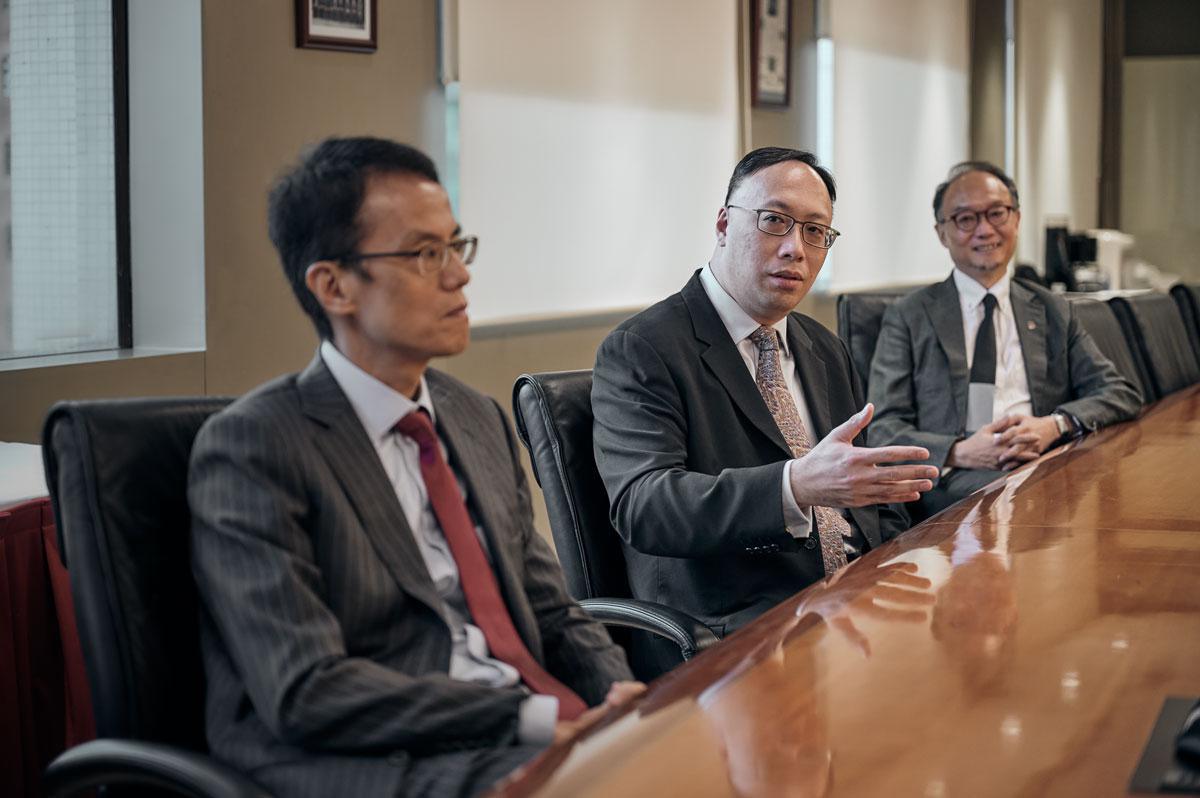Hong Kong is set to introduce a procedure, similar to the company administration process in the United Kingdom and elsewhere to give struggling companies the opportunity to get back on their feet. The draft Companies (Corporate Rescue) Bill, which is currently out for consultation, would introduce a statutory framework for corporate voluntary arrangements for the first time in the jurisdiction.
While Hong Kong already has a number of options for companies that run into difficulties, its lack of a formal restructuring regime has long been seen as an issue. Ludwig Ng, Senior Partner at ONC Lawyers and a member of the Hong Kong Institute of CPAs’ Restructuring and Insolvency Faculty Executive Committee (RIFEC), points out that in the World Bank’s 2017 Doing Business rankings, Hong Kong moved down one place because of its lack of a corporate rescue statutory framework.
(From left) Ludwig Ng, Senior Partner, ONC Lawyers, Daniel Chow, Senior Managing Director, FTI Consulting, Johnson Kong, President, Hong Kong Institute of CPAs, Terry Kan, Partner, ShineWing, Tiffany Wong, Managing Director, Alvarez & Marsal Asia and Mat Ng, Partner, Strategy and Transactions, EY
Mat Ng, Partner, Strategy and Transactions, an Institute member and former Chairman of RIFEC, added that the World Bank survey is important, noting that Singapore was upgraded after it amended its insolvency laws. Hong Kong’s ranking can also affect borrowing costs. When banks assess risk factors in a jurisdiction in setting their interest rates, the Doing Business report is one of the things that they reference.
The lack of a proper framework for corporate rescue is a disincentive for investors, as insolvency laws are one consideration when they decide where to invest, says Daniel Chow, Senior Managing Director at FTI Consulting, an Institute and RIFEC member. If companies end up having to be wound up when they face liquidity problems, this is not good for Hong Kong’s reputation as business-friendly environment.
There is also another economic cost to not having a mechanism to enable companies that have run into difficulties to turn themselves around. “When a company is in financial distress, if you rescue it instead of liquidating it, the company’s losses can be minimized, jobs can be saved, and valuable intangible assets can be preserved,” Ludwig Ng says.
Current restructuring options
Johnson Kong, the Hong Kong Institute of CPAs’ President, and Managing Director – Non Assurance at BDO, points out that while there are currently a number of options for corporate restructuring in Hong Kong, they all have drawbacks.
For example, there are voluntary workouts driven by the banks, on which the Hong Kong Monetary Authority issued the guidance Hong Kong Approach to Corporate Difficulties in 1999. Although this works pretty well it only applies to banks and not other creditors. Under the Companies Ordinance, a company may reach a compromise with its creditors on a voluntary basis, or go through a scheme of arrangement, but the scheme must be sanctioned by the court and approved by a majority of creditors. However, these procedures lack a moratorium, meaning that an individual creditor can still petition for a winding up order. Another option involves appointing a provisional liquidator, a route that has been developed through case law. But Kong points out that while insolvency practitioners are able to use this option to carry out a restructuring, courts have reminded practitioners that it is not the main purpose of the provisional liquidation provisions.
“What we need in Hong Kong is more tools for companies on the verge of bankruptcy or insolvency so that the company can survive.”
Chow adds that Hong Kong’s current insolvency regime is also very creditor-friendly and focused on the recovery of assets, leaving limited scope for companies that want to turn themselves around. “What we need in Hong Kong is more tools for companies on the verge of bankruptcy or insolvency so that the company can survive, rather than allowing the creditor to liquidate it and realize all the assets,” he says.
Mat Ng says on the plus side, the existing framework is transparent and predictable, as it follows the common law approach, but he also agrees that because it still follows the U.K.’s old insolvency regime, Hong Kong is losing ground to other jurisdictions, such as Singapore, which is promoting itself as a restructuring hub. “Everyone else has been modernizing their insolvency regime except us, so it is very difficult for us to compete with other major financial centres around the world when we still have an outdated system,” he says.
Despite the drawbacks, Terry Kan, Partner at ShineWing, an Institute member and Chairman of RIFEC, says the current system does have strengths, pointing out that it is efficient and there are many top professionals in Hong Kong looking after the interests of stakeholders. Recently, the court has also recognized a “light touch” provisional liquidation procedure, enabling the provisional liquidator to work with the management to find a solution, which is a kind of hybrid arrangement between the Chapter 11 procedure in the United States and a voluntary arrangement. Even so, he agrees the new framework would offer a valuable additional option to companies in distress.
Ludwig Ng supplemented that the “light touch” provisional liquidation was actually a procedure developed in Bermuda and the Cayman Islands, but the Hong Kong court has taken the initiative to recognize it. Given that many Hong Kong businesses are incorporated in those jurisdictions, they have the option to make use the procedure. The Hong Kong court’s flexibility is helpful because Hong Kong has not so far adopted the United Nations Commission on International Trade Law (UNCITRAL) model law on cross-border insolvency, which is a widely-adopted framework to encourage cooperation and coordination between jurisdictions in cross-border cases.
A long history
The journey to the current draft bill has been a long one. It began in 1996, following recommendations from the Law Reform Commission on the need to introduce a formal corporate rescue and insolvent trading framework in Hong Kong. Attempts to pass the bill in 2000 and 2001 failed in the Legislative Council over disagreements about the way outstanding entitlements to employees should be handled.
The legislation was revisited in 2009 in the wake of the Global Financial Crisis. “I was a member of the Standing Committee on Company Law Reform at the time and I still remember in January 2009, the then Chief Executive Donald Tsang was really worried, and he gave his instruction that we needed to have the law on corporate rescue in place as soon as possible,” Kong says. “We had weekly Saturday morning meetings just to churn out the consultation paper. But Hong Kong bounced back quite quickly, so the pressure was off, and it was put on the backburner again.”
Detailed proposals on the issue were again published in May 2014, with a view to including provisions for corporate rescue in the new Companies Ordinance that year, but they were later excluded.
The current draft bill is largely based on the 2014 proposals. It would give companies the option of appointing a provisional supervisor, who would be a CPA or qualified solicitor, to replace the board of directors. The provisional supervisor would draw up a proposal to maximize the company’s chances of continuing as a going concern, which would then be voted on by its creditors.
A moratorium, to give the company “breathing space” from action by its creditors, would be in place for 45 days, with the option for it to be extended for a further six months, with the provisional supervisor able to apply to the courts for an additional six months if necessary.
Mat Ng says: “The new legislation means we will have other options we can use for suitable companies, which will lead to a more effective and less costly approach.”
Tiffany Wong, Managing Director at Alvarez & Marsal Asia, an Institute and RIFEC member, points out that having a moratorium in place is also a significant benefit of the new approach, as the current lack of a moratorium makes insolvency practitioners’ job much harder. “Without a moratorium we can’t stop creditors from taking unilateral action, which is not necessarily in the best interests of the company or the general body of creditors. It just takes one of them to file a winding up petition then the entire process falls apart,” she says.
Unresolved issues
Despite the benefits the draft bill would bring, RIF members still have some concerns. One of these relates to the level of personal liability the provisional supervisor may have to take on.
Kong points out that concerns among insolvency practitioners about these liabilities could also limit take up of the new process as there may be a shortage of practitioners who are willing to act as the provisional supervisor. The Official Receiver Phyllis McKenna has made clarifications on this issue. See her profile A balancing act for further details.
One drawback is the lack of options for rescue financing. Wong explains: “When a company is in distress, without the option of super-priority lending, it may be difficult to attract new investors.” Wong also hopes that the bill will allow the provisional supervisor to borrow money against the assets of the company. “Businesses may just lack liquidity, rather than have a performance issue. I think allowing the provisional liquidator to borrow money would be useful in the current environment.” Kan is also concerned that the legislation is still too complicated. “It has over 400 sections, which was quite a task for the lawyers and accountants in town to read and comment upon. “Ideally, we would like it to be concise, readable and, most importantly, something creditors can buy into. We would like it to be user-friendly.” Chow agrees, pointing out that the bill should be accessible to the lay person, so that it is easy for companies to understand what options are available to them.
Ludwig Ng says the draft bill also contains a lot of provisions aimed at preventing abuse. “While sometimes directors and business owners use winding up as a way of trying to avoid their liabilities, I think a balance has to be struck between making the process more flexible or user-friendly and preventing abuse,” he says.
Mat Ng feels that the legislation needs to show more trust in practitioners and the process, and not provides so too many opportunities for the court to intervene. “At the moment the bill is drafted in a way that seems to indicate a lack of trust between the stakeholders, so there are a lot of situations where the court could get involved,” he says. He would also have preferred it if the new regime were more debtor friendly. “A debtor-friendly regime promotes entrepreneurship, but unfortunately in most Asian countries, the culture is still creditor friendly and the insolvency regimes treat companies as if they have done something wrong, instead of seeing the laws as a tool for rehabilitation,” he says.
In addition to local companies, the draft bill will also cover registered non-Hong Kong companies, i.e. companies registered under the Companies Ordinance but incorporated elsewhere, as many Hong Kong-listed companies nowadays are incorporated in Mainland China or in offshore jurisdictions. However, there are no specific provisions for dealing with cross-border insolvencies in the draft bill.
Kan says the courts are also looking at how to deal with insolvent companies that are listed in Hong Kong but do the majority of their business and have most of their creditors in Mainland China. “It can be very complicated. Should the lead be taken in the Mainland or by Hong Kong creditors? The Hong Kong court is quite pragmatic,” he says.
Wong adds that Hong Kong courts have also recognized the need for Mainland administrators to act in Hong Kong to preserve companies’ assets here. “We are hoping the Mainland courts will reciprocate and recognize our Hong Kong appointment in Mainland China,” she says. Mat Ng points out that as the Mainland has a corporate rehabilitation law, once the corporate rescue framework is in place, there may be a chance of getting recognition for some Hong Kong appointments. Currently, the Mainland courts do not recognize administrators of schemes of arrangement because schemes are not always insolvencies.
Measuring the impact
The draft bill is expected to be introduced in the next session of the Legislative Council , but if it is passed, it is not certain when it will be fully implemented. Even if it comes into effect immediately, it is still likely to take time before it is widely used. “Looking at the statistics on Individual Voluntary Arrangement, going back to 1996, it took two to three years for the market and practitioners to get used to and understand exactly what it meant,” Kan explains.
He points out the corporate rescue process is more complicated, so it could take longer for it to be widely adopted. “Practitioners will need to promote its benefits to the market so that people understand it is a good tool. It may take one or two years before they can really see that it is useful,” he says.
Chow agrees: “Once the bill becomes law, I think it is important for the government and professionals to promote this approach to the public, bankers and other professional organizations so that they understand it is a new option for a company in trouble.”
He adds that the role of accountants is not limited to insolvency practitioners acting as the provisional supervisor, but the Institute should also promote the new legislation more widely to its members. “If in-house accountants, auditors, and lawyers know in detail how it works, they could save a company from going into liquidation by recommending it to the management,” he says. Ludwig Ng adds that accountants on audit committees should also alerted to the new options. With new provisions on insolvent trading being introduced alongside the bill, directors will also need to be aware of the pitfalls of not initiating rescue action before it is too late.
While accountants clearly have a key role to play, Wong points out that acceptance of the new regime by the banking sector will also be critical to its success. “It is clear that the consent of the major secured creditors is needed. I have had discussions with other practitioners, and we are a bit concerned about how quickly or how willingly the banks will provide their consent in individual cases, otherwise a corporate rescue procedure will not go anywhere,” she says. Chow points out that the situation could be further complicated by the fact that often major secured lenders are no longer traditional banks, and may be investment banks, securities companies, or even other corporate lenders.
“If in-house accountants, auditors, and lawyers know in detail how it works, they could save a company from going into liquidation by recommending it to the management.”
Another measure of the success of the new procedure will be the range of different companies that are able to use it. Kong believes that the procedure is more likely to be used by larger companies. Ludwig Ng, expects the procedure to be used by companies with few creditors, while Mat Ng adds that it would be suitable for investment holding companies with few employees and mainly financial institutions as creditors. Kan hopes that after the bill has been implemented that the government will consider a simplified version of the new regime for small- and medium-sized enterprises.
Overall, practitioners welcome the new corporate rescue procedure as a useful addition to what is currently available. “It is always good to have one more tool in our toolbox,” Kan says. Insolvency practitioners generally agree that, even if the procedure is not perfect, it will be better for Hong Kong to have a statutory corporate rescue procedure in place and try to improve it over time.























